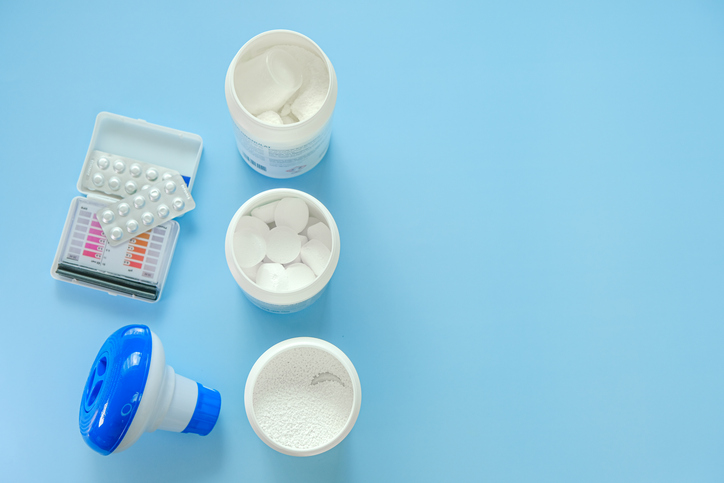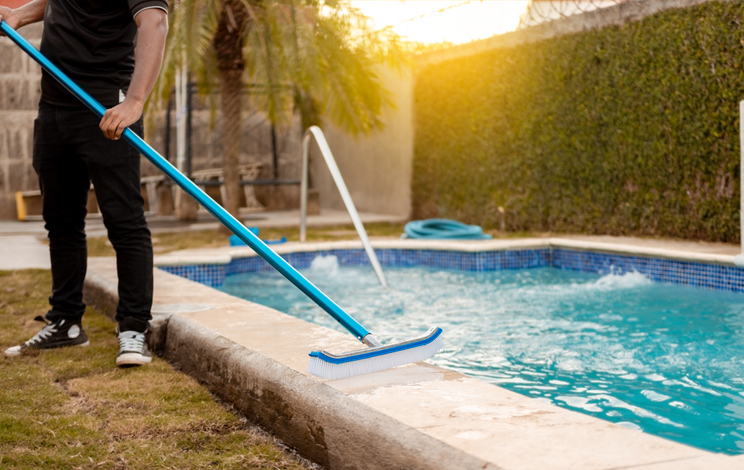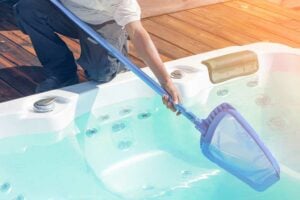Nothing beats the pleasure of taking a dip in your pool during the summer as temperatures soar and humidity climbs!
To truly enjoy your pool to the fullest, it’s important you’re taking proper care of it. In fact, the high temperature can make your pool a perfect breeding ground for algae, bacteria, and other organisms.
Within no time, sparkling, crystal-clear water can turn cloudy, and if action isn’t taken, you may find yourself staring at an unattractive pool that is become a health hazard.
We’re officially a month into the swimming season, and now’s the perfect time to review your pool maintenance routine and revamp it as needed to maximize the health of your water!
From keeping the walls clean, to adding those doses of shock, every step in your routine plays a crucial role in keeping your pool water clean and safe to enjoy all season long!
So, are you curious if your routine is missing a vital component or if your existing schedule deserves a round of applause?
Read on to discover the answer!
6 Pool Maintenance Basics for Crystal-Clear (Safe) Water
Unlike your bath water, your pool is constantly exposed to the outside elements, which means rain, dirt, bugs, and even the occasional small animal!
This makes your pool maintenance crucial in maintaining clean water that is welcoming for both you and your guests.
Luckily, with the right steps, you can easily maintain your pool like a pro!
1. Check the Chemical Levels Every Week
To give your pool the lustrous blue it deserves and give its chlorine an added boost, check its chemical levels every week.
There will be three main components you’ll want to be looking at when you test your water:
- pH
- Alkalinity
- Sanitizer
You’ll want to maintain a pH level between 7.2 and 7.6 and alkalinity levels around 80 and 120 ppm (parts per million).
If your pH or alkalinity is off balance, you risk your water becoming too acidic or too basic, resulting in corrosion or scale buildup.
When it comes to your sanitizer, the levels you’ll need to maintain for safe water will depend on which sanitizer you use in your pool, such as chlorine or bromine.
If you’re using chlorine, you’ll want to maintain sanitizer levels of 1 to 3 ppm, but for bromine, you’ll be aiming for levels between 3 and 5 ppm.
2. Use the Right Chemicals
With the chemical makeup of your water being so crucial, using the right products to treat your water is an important step.
For the pH and alkalinity mentioned above, you’ll need to keep the following products on hand:
- pH increaser
- pH decreaser
- Total alkalinity increaser or baking soda
These products will help you properly rebalance your water anytime either level falls out of balance.
It’s important to note that when adding these products to your pool water, you’ll want to start with your alkalinity treatments before adjusting your pH.
pH is highly influenced by alkalinity, so by balancing your alkalinity first, you’ll need to add fewer products and have an easier time bringing everything back into balance.
While we touched on chlorine above, some other chemicals you may want to include in your routine are:
- Calcium hardness increaser
- Algaecide
- Stain removers
Depending on your local water, you may need to add a calcium hardness increaser to boost its overall calcium content, making it easier to balance and reduce the risk of corrosion.
Algaecide is good to have on hand for those times when you discover algae blooms beginning to form in your water.
It works by stopping the spread while you take the necessary steps to kill the algae, such as shocking the water.
If your local water contains high levels of metals, such as iron or copper, it may leave stains behind on your liner.
To combat this, you can include a stain remover or metal sequestrant in your water treatment routine.

3. Don’t Skip Shock Treatments
Next on the list is shocking your water. Shock works to support your regular sanitizer by adding a super dose to your water.
One of the best shock options is an oxidizing shock to help combat those stubborn oils that your sanitizer isn’t able to effectively break down.
While this is usually done once a week, there are times when it’s a good idea to add a dose to your water.
Some times when you’ll need to break from your schedule and add an extra dose include:
- Following a pool party
- When temperatures suddenly surge
- After a heavy rain
- If your water has a strong chlorine smell
Each of these events has a significant impact on the quality and contaminants in your water, and following them up with a shock treatment will help boost your sanitizer levels once again.
An important factor to note is when to add your shock. If you want to maximize its effectiveness, add shock to your pool in the evening after the sun has gone down. This gives it time to work without the sun deteriorating it faster than expected.
4. Keep Up with Your Weekly Clean
With so many things on your summer bucket list, it’s easy to put off cleaning your poo, and unfortunately, this can result in your pool developing long-term problems that can be expensive to correct.
You should be cleaning your pool once a week, and this includes:
- Brushing the walls and bottom
- Vacuuming
- Skimming the surface
- Cleaning your surrounding area
These steps help keep sediment from clinging to your walls, forming a layer of slippery grime. Not only is it unappealing to feel, but it drastically increases your risk of algae forming in your water!
5. Get your Pool Inspected
The best time to get your pool inspected would be before the start of the swimming season. However, including one in the middle of the summer is also a good idea.
Since your system has been running for many weeks, warning signs of potential issues that weren’t there at the beginning of the summer may have begun developing.
One area that should be given close attention is your filter. It needs to be cleaned regularly to prevent your pool from becoming murky or discolored.
Other areas that should be inspected and cleaned include the skimmer box and skimmer basket.
6. Include Professional Pool Service
Last but certainly not least is the inclusion of a professional service.
This can provide ample benefits, from catching potential issues early, helping you better care for your water, and simply having a professional verify your routine is working as intended.
Best of all, these services are a great way to support your pool during those times when your schedule just simply doesn’t allow for thorough care, such as when you’re on vacation!
Pool Maintenance and Service in Greensboro
To keep your pool in perfect condition throughout the summer, it’s best you partner with a professional pool maintenance service provider.
AquaVision Pool & Spa are qualified and experienced pool care professionals who can help you with everything from chemical balancing, routine cleaning, equipment repair, and even vinyl liner replacements.
Whether you’re struggling to keep your water balanced or simply need a team to support your routine care, our experts are here to help.
To schedule a pool maintenance service, feel free to contact AquaVision Pool & Spa today!




 by
by 
